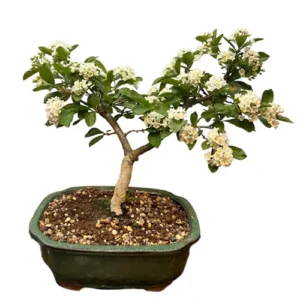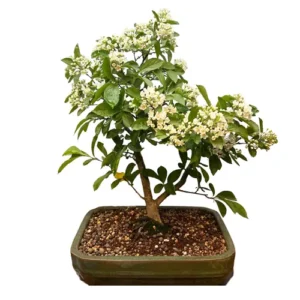Morus
Mulberry Bonsai
Cultivated for thousands of years in China as well as native to Southwest Asia and North America, Morus are hardy species known for their famous fruits. Dependable bonsai, Mulberry’s leaves and fruit grow to scale as Bonsai. Its three species grow three different colours of fruit, white, black and red.
Mulberry Bonsai Care Tips
Placement
Mulberry make for hardy bonsai in temperate climates. This being said they possess fleshy roots which need protection from harder frosts. Throughout the growing season keep these bonsai in full sun.
Watering
Across the growing season, Mulberry requires watering regularly. This is vital during summer particularly. During the winter, be sure to keep the soil consistently moist.
Feeding & Fertilising
Feed your Mulberry bonsai during the growing season. A general fertiliser should be used in the middle of summer. Transition to a low-nitrogen one toward the end of summer.
Pruning & Wiring
Pruning should be done at the start of Spring for shaping then once again after flowering towards the end of Summer. When the shoots have over-extended trim back to two or three new leaves, to encourage new shoots and maintain the shape of the tree. Hollowing out the trunk, if desired, should be done during the spring and summer to allow quick recovery.
Repotting
Repotting your tree is an important way to provide a fresh and suitable soil mix and ensure appropriate root health. Mulberry bonsai need repotting every other year at the start of Spring.
Trees that are ready for repotting will require root pruning, a suitable new pot and appropriate soil mix.
When repotting, do not cut back the root mass by a large amount, and choose a well-draining soil mix that has a neutral or slightly higher PH value of 5-6 but not over 7. We tend to use a mixture of different speciality bonsai soils on our trees. Every species is different so please contact us for free soil-mix advice or to take advantage of our repotting service.
Bonsai trees aren’t only magnificent additions to an indoor oasis, they are more than capable of standing out in any garden. Many Bonsai species are incredibly hardy and withstand nature’s colder and damper turns with aplomb making them worthwhile outdoor plants. We have an extensive library of care guides for outdoor bonsai trees. It’s not about selecting the perfect bonsai, it’s about selecting the perfect bonsai for you.
Mulberry Bonsai - Typical Queries
Is Mulberry good bonsai for beginners?
Mulberry is a fairly easy bonsai to keep and train. Care should be taken when pruning but its feed and watering regime is straightforward. Beginners will likely fare well with a Mulberry.
Do Mulberry bonsai get pests and diseases?
Mulberry bonsai are susceptible to a few pests. Silkworms enjoy feeding on this species along with caterpillars. They can be picked off as soon as spotted. Aphids can also be a problem and if not by hand can be removed with water or insecticide.
Can you keep a Mulberry bonsai indoors?
This is a considerably hardy and rustic plant, it should be kept outdoors. While its roots may need a little protection at points, keeping Mulberry indoors is not advised.





















